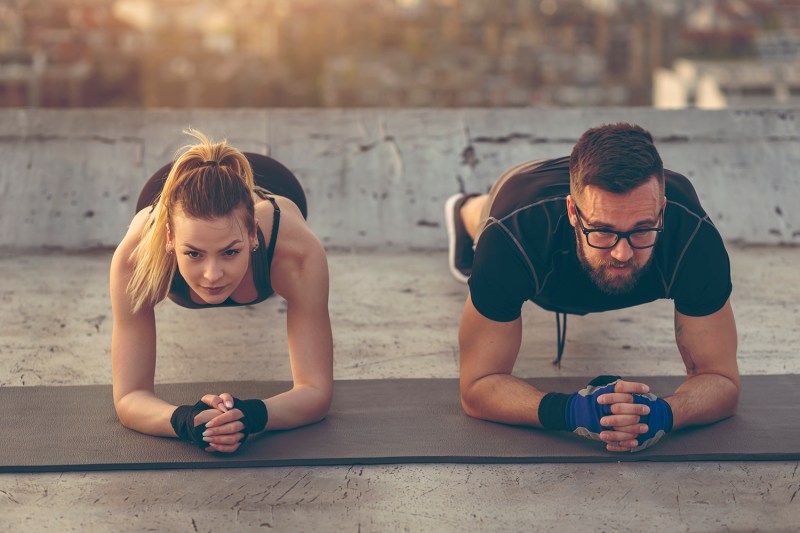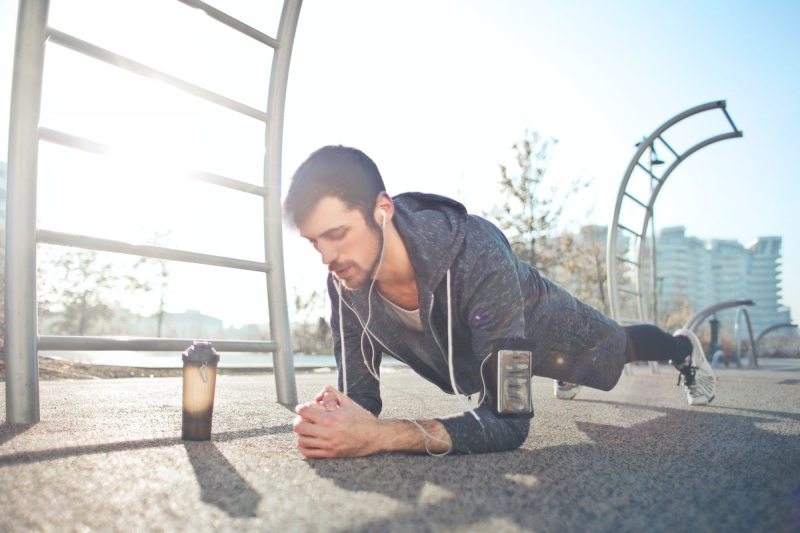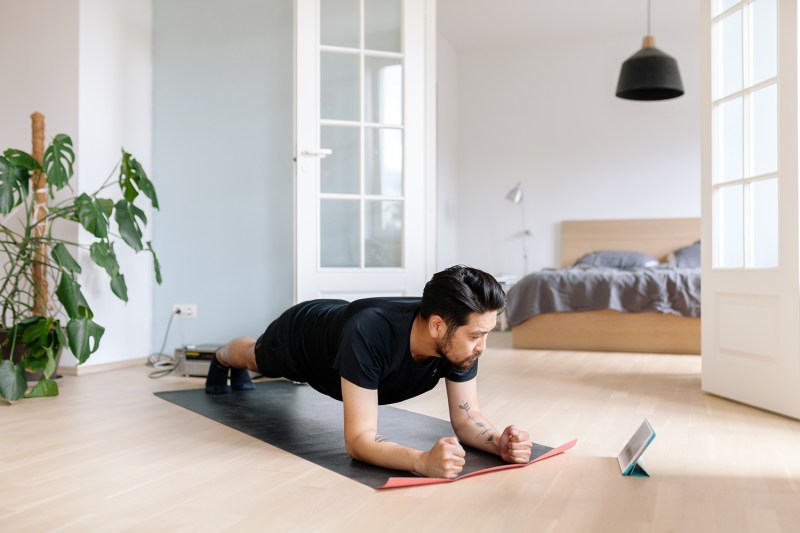Planks are a very common exercise, and for good reason — they really work! Whether you love them or hate them, you can’t deny how effective they can be. When it comes to bodyweight exercises, planks are one of the best, as they strengthen the core and upper body. You can also adjust them depending on your fitness level.
However, while planks look simple, since they only involve maintaining a static position, they can be tricky to master, and in order to reap the full core-strengthening benefits and prevent potential injuries, executing a plank with proper form and technique is critical. Keep reading for everything you need to know to perform perfect planks, including easier and more advanced modifications you can tackle as your fitness improves.
Anatomy of the abdominals
Overall, there are four primary abdominal muscles, and they include the external obliques, internal obliques, rectus abdominis, and transverse abdominis.
- The internal and external obliques are located on the sides of your abdomen, and they run diagonally in opposite directions of each other. As the names suggest, the external obliques are located on top of the internal obliques.
- The transverse abdominis is also located on your sides, and it runs horizontally across your abdomen.
- Your rectus abdominis runs up and down the center of your core and is often what people are thinking of when they speak of a six-pack.
These muscles do so much for the human body, and they’re the core for a reason! They provide stability and strength with every daily movement, create a home for your internal organs, help you maintain proper posture, and more.
Benefits of plank exercises
Planks have earned their well-deserved seal of approval from nearly every trainer and strength and conditioning specialist due to the array of benefits they provide. We often think of ab exercises as just the fast track to a six-pack, and while planks can certainly help you get a sculpted and chiseled torso, they actually do more than just strengthen your abs.
Planks target your entire core — the superficial and deep abdominal muscles, obliques, glutes, back, and hips. Having a strong core is critical for injury prevention and optimal physical performance, whether in the gym, doing yard work, fixing things around the house, or running in a race.
The function of the core is to stabilize the body, such that the upper and lower body have a stable anchor from which to move. The core links the upper and lower body and helps coordinate and orchestrate efficient, safe, and powerful movements.
A plank is considered an anti-rotational exercise, which makes it a functional core exercise because a plank mimics the real-life purpose of the core — to provide a stable anchor for the limbs, resisting rotation. This is why regularly performing planks puts a metaphorical ace up your sleeve as an athlete. The physical benefits bleed into all other areas of your workout prowess and up your game in everyday life.
The benefits of planks include the following:
- Improves posture
- Strengthens shoulders, chest, and upper back
- Builds core strength and stability (abs, hips, low back, glutes)
- Helps prevent low back pain and injury risk
- Develops neuromuscular (mind-body) connection to the deep, stabilizing core muscles like transversus abdominis

How to perform a plank
The key to reaping the benefits of any exercise is performing it correctly. Here is how to do a perfect plank.
- Get into a push-up position, but drop down so that your forearms are on the floor. Your elbows should line up directly underneath your shoulders, and your toes stay on the ground.
- Engage your glutes and draw your belly button up to your spine while keeping a neutral spine and neck for the duration of the exercise. Your body should be in a straight line from your head to your feet.
- Be sure to breathe throughout the exercise, and don’t let your hips sag. Actively push your heels away from you to promote good form.
Start with 15 seconds, and gradually work your way up to 3 minutes, stopping if your form starts to break down.

Plank modifications
There are many ways to regress, progress, and vary planks to meet your fitness goals and abilities. Here are some of our favorites!
Beginner version
For an easier modification, perform the normal forearm plank, but drop down so that your knees are on the ground.
Up-down plank
This dynamic version will give your upper body a workout.
- Start in a plank position with your elbows on the ground.
- Push one hand into the mat until your elbow is straight, and then do the other hand so that you end up in a push-up position. Your hands should be directly underneath the shoulders.
- Lower back down onto your elbows with control, one side at a time.
- Keep repeating this pattern, switching the arm that is pushing up to the top position every time.
Be careful not to rock your hips. Keep them as stable as possible by keeping your core and glutes engaged. Slow down if you feel them moving.
Plank jacks
In this challenging move, you’ll reap all the benefits of a regular isometric plank while also getting a cardio workout. You can perform this exercise from either the standard forearm plank position or the push-up position.
- Maintaining a tight core and good form, splay your legs as you jump them out to their respective sides away from your body.
- Jump them back in and out rapidly and repetitively, keeping your hips down so that you’re still in a straight line from your head to your feet.
Side plank
This is another anti-rotational exercise, but the focus is on your obliques, the muscles of your side of the torso that help with bending and rotational movements.
- Lie on your side with your legs stacked on top of each other.
- Push up and straighten the arm on the side of your body that is resting on the ground so that your whole body lifts up into the air. Your arm remains straight, your legs remain straight, and your feet stay stacked one on top of the other.
- Concentrate on pushing your top hip up to the ceiling.
- Hold this position for 30 seconds, or stop early if your form waivers.
Plank with front raise
This modification helps your entire core develop the strength to stabilize your body during movement. It enhances the anti-rotational demands of a standard plank.
- Get into a push-up position, maintaining a straight line from your feet to the top of your head.
- Without raising your butt into the air, lift one arm up and forward, straightening it out so that it is parallel to your face.
- Hold for 1 second and then return to starting position. Keep your legs locked and don’t allow any swaying side to side as you switch arms.
- Alternate arms, aiming for 12 repetitions on both sides. You can add a dumbbell to increase the intensity of the move.

Tips for perfecting your plank game
While the plank exercise is fairly straightforward, there are a few things to keep in mind to help you master it and get the most out of your efforts.
- Do not let your hips sag, as this can put a strain on your lower back.
- If you allow your glutes to stick up in the air, your abs are not going to be challenged as much, and this will pull from the purpose of the exercise.
- Focus on pulling your hips forward and your belly button up toward your spine to maximize the burn.
- Keep your shoulders directly above your elbows to prevent unnecessary strain on your rotator cuffs.
- Place your feet a bit wider than hip-width apart to help with stability and to maintain your body in a straight line.
Frequently asked questions
How long should the average person be able to hold a plank?
Being able to hold a plank for 30 seconds is a great place to start. Try to gradually add 10 seconds at a time until you are able to reach your goal!
How do I know if I’m planking correctly?
If your abdominals feel challenged and you don’t feel any strain in your lower back, shoulders, or elsewhere, then you are likely planking correctly. Remember to focus on keeping your body in a straight line for the duration of the exercise.
Is a 2-minute plank good?
Being able to hold a plank for 2 minutes while maintaining the proper form is great! This is an indication that you have a strong core; it may now be time to try some more challenging modifications.





